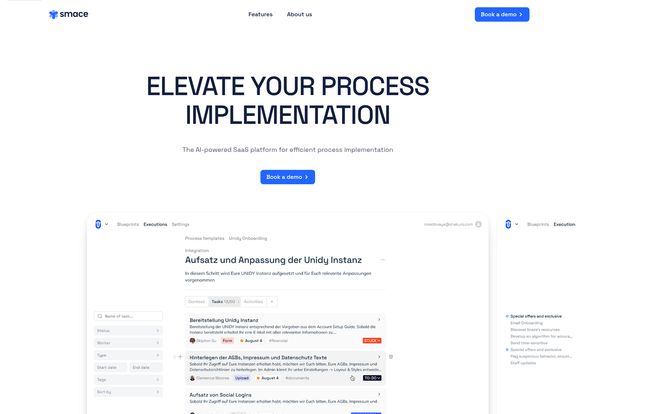Let’s have a little heart-to-heart. You’ve been there. I’ve been there. We’ve all been there. You spend weeks, maybe even months, crafting the perfect process on a whiteboard or a fancy flowchart app. It’s beautiful. It’s logical. Every step flows into the next like a serene river. You present it to the team, everyone nods, and then... reality hits.
The serene river turns into a chaotic mess of missed emails, outdated spreadsheets, and people asking, “Wait, whose job was that again?” That beautiful gap between process design and process execution is where productivity goes to die. It’s a frustration I’ve felt deep in my bones for years as an ops and traffic-focused guy.
So, when I stumbled upon a tool called Smace that claims its entire reason for being is to “bridge the critical gap between process design and execution,” my ears perked up. A bold claim. But could it be true? Is this the platform that finally gets the orchestra playing from the same sheet music? I decided to take a closer look.
So, What on Earth is Smace, Anyway?
Okay, first off, let's get one thing straight: Smace isn't just another project management tool. We have plenty of those, right? Think of it less like a to-do list and more like a conductor for your company’s most complex symphonies. It’s a collaborative, AI-powered platform specifically built for process implementation. Big words, I know. But stick with me.
Imagine you’re onboarding a major new client. This isn't just a few tasks. It involves sales, legal, tech setup, customer success, and finance. It’s a multi-stakeholder nightmare waiting to happen. Smace is designed to take that complex, multi-department process and turn it into a streamlined, transparent, and repeatable workflow that everyone can follow. It takes your perfect blueprint and gives your team the power tools and instructions to actually build the house without arguments over who was supposed to install the windows.
It’s about creating a single source of truth for your most important, repeatable procedures. A real game changer. If you do it right.
The Core Features That Actually Matter
Any platform can throw a bunch of features at you. But after poking around, I think Smace’s power comes down to a few key areas that work together.
Customization is King
I have a low tolerance for rigid software that tries to force my team into its box. Smace seems to get this. The emphasis on customizable forms and workflows is huge. You’re not stuck with a generic “intake form.” You can build out the exact fields, steps, and logic your specific process needs. Whether it's for product onboarding, a quality assurance check, or a new hire setup, you tailor the workflow to your reality, not the other way around. This flexibility is what separates a useful tool from a frustrating one.
Collaboration That Doesn't Feel Forced
The platform is designed to unify teams and, as they say, “break down organizational barriers.” This isn't just marketing fluff. By creating a single, shared view of a process, you eliminate the endless “cc” chains and Slack messages trying to figure out the status of a project. Everyone from different departments can see the same instance, understand the context, and know exactly what’s required of them. It promotes that effortless coordination we all dream of but rarely achieve.

Visit Smace
AI That's Actually Useful (I Think)
Ah, “AI-powered.” The two most overused words in tech right now. I'm naturally skeptical. But here, it seems to be applied with purpose. Smace uses its AI for insights and data-driven decision support. In plain English, this means it can help you spot bottlenecks. It can analyze your completed processes to show you where things are consistently slowing down. Why does the legal review step always take three days longer than planned? Smace can give you the data to answer that question, so you can fix the leak instead of just constantly mopping the floor. That's an AI application I can get behind.
Who is Smace Really For?
If you're a freelancer managing your own tasks, this is probably overkill. Smace shines in a team environment, especially for:
- SaaS companies with complex customer onboarding.
- Product teams launching new features with multi-step internal processes.
- Agencies managing intricate client implementation projects.
- HR departments streamlining the new-hire onboarding experience.
Basically, if you have a critical process that involves multiple people across multiple departments and absolutely cannot fail, Smace is built for you. I also noticed the “Made in Germany” tag and the German text in their screenshots. This isn't just a fun fact; to me, it hints at an engineering-first, precision-oriented mindset, which is exactly what you want from a tool designed to manage complex processes.
The Good, The Bad, and The Setup
No tool is perfect. Let's get real and look at both sides. Based on the info out there and my experience with similar platforms, here's my take.
| What I Like (The Pros) | Things to Keep in Mind (The Cons) |
|---|---|
| Gets everyone on the same page, eliminating chaos and improving efficiency. | There's an initial setup investment. You have to thoughtfully design your processes. |
| Highly customizable to fit your actual, real-world workflows. | Its effectiveness really depends on how well you design your processess. Garbage in, garbage out. |
| Advanced integration capabilities mean it can connect to the tools you already use. | There will likely be a learning curve for the team as they adopt a new way of working. |
A Few More Thoughts on This
The cons aren't really deal-breakers; they're just... realities. You can't expect a powerful tool to magically fix a broken process without any effort on your part. The fact that it requires a thoughtful setup is actually a good thing. It forces you to critically evaluate how you work and to codify best practices. The payoff for that initial work—in terms of saved time, fewer errors, and happier teams—could be immense.
Let's Talk Money: The Smace Pricing Question
Alright, the question every business owner is asking: what's this going to cost me? I did what any good researcher would do—I went looking for the pricing page. And I hit a 404 “Page not found.”
Honestly? I’m not surprised. And it’s not necessarily a bad thing. For a specialized B2B tool like this, a public pricing page often doesn’t make sense. The value and the cost are so tied to your team size, your usage complexity, and the specific integrations you need. This almost always means they operate on a “Book a Demo” model. You talk to them, they understand your needs, and they give you a custom quote. It’s a higher-touch approach, but for a platform that’s meant to become the backbone of your operations, it’s the right one.
Smace vs. The Usual Suspects
So how is this different from, say, Asana, Trello, or Monday.com? Those tools are fantastic for task and project management. They are the digital equivalent of a very organized whiteboard. Smace is different. It's not about managing a one-off project; it's about codifying and executing a repeatable process. It's more structured, more focused on the flow and the handoffs between stages than just a list of tasks to be checked off. It’s a process engine, not just a project tracker.
Final Thoughts: Is Smace the Missing Link in Your Workflow?
After digging in, I’m genuinely intrigued by Smace. It's targeting a very real, very painful problem that most growing companies face. The chaos of process execution is a silent killer of productivity and morale. Smace seems to be a thoughtful, powerful, and well-engineered solution to that specific problem.
It’s not a magic wand. You'll have to invest the time to map out your workflows and get your team on board. But for organizations that are ready to move from frantic, ad-hoc execution to streamlined, repeatable excellence, Smace might just be the bridge you’ve been looking for. It has the potential to turn your most complex processes from a source of dread into a competitive advantage.
Frequently Asked Questions about Smace
- What is Smace best used for?
- Smace excels at managing complex, multi-stakeholder processes that need to be repeated consistently. Think customer onboarding, new hire integration, detailed product launch sequences, or quality assurance workflows.
- Is Smace difficult to set up?
- There is an initial setup phase where you need to define and build your processes within the platform. While there may be a learning curve, this initial investment is what makes the tool powerful. Its effectiveness is directly tied to the quality of the process design you put into it.
- Does Smace integrate with other tools?
- Yes, the website highlights "Advanced Integration." This suggests it's designed to connect with your existing tech stack (like your CRM, communication tools, etc.) to create a more unified workflow and reduce manual data entry.
- Who is behind Smace?
- The co-founder listed on the site is Henrik Lippke, who has over 20 years of programming and development experience. The company appears to be based in Germany, which often implies a strong focus on engineering and data security.
- Is there a free trial for Smace?
- There's no public mention of a free trial. The main call-to-action is to "Book a demo." Typically, for enterprise-focused software like this, access to a trial or a sandbox environment is discussed during the initial demo call with their sales team.
- How is Smace different from a tool like Monday.com or Asana?
- While tools like Monday.com are excellent for project and task management, Smace is a dedicated process implementation platform. It's less about managing a one-time project's tasks and more about creating a standardized, repeatable engine for your core operational processes.



